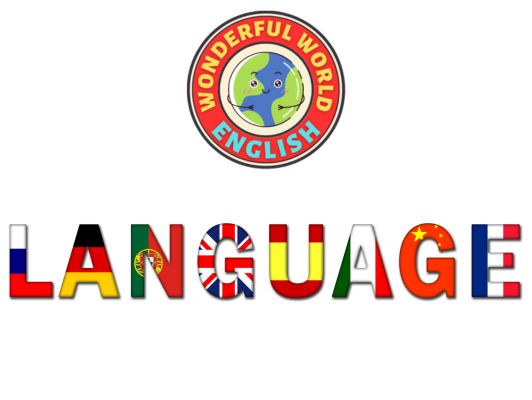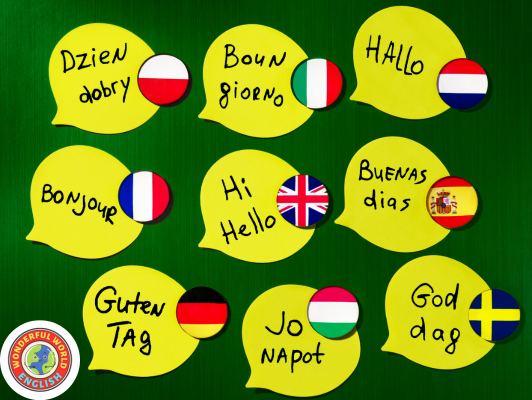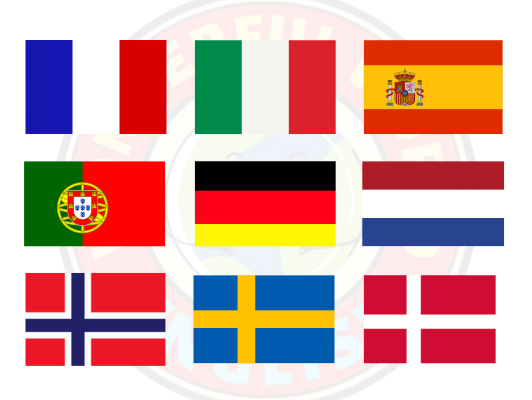Contents
Toggle
Meet David De’ Ath, founder, editor, and writer at Wonderful World English. With his extensive background as an English teacher, David provides valuable insights and practical tips on ESL for students and teachers alike.
Learning a new language can be a thrilling and enriching experience, opening doors to new cultures and perspectives.
For English speakers, certain languages come with a degree of relative ease when it comes to learning and achieving fluency.
Factors such as shared linguistic roots, grammar structures, and vocabularies tend to make these languages more accessible.
The challenge, however, lies in identifying which ones align closely with the English language and can be considered “easier” to learn.
Resources for language learning are more abundant than ever, significantly influencing the language learning culture.
With a myriad of digital tools, community courses, and online forums, English speakers today are better equipped to tackle the task of learning a second language.
Additionally, understanding the common challenges and effective strategies to overcome them can provide potential learners the confidence needed to embark on the language acquisition journey.
Key Takeaways
- Certain languages offer English speakers an easier learning curve due to similarities in linguistic structures.
- A wealth of resources and a vibrant culture of language learning support the pursuit of a second language.
- Practical strategies and a clear understanding of common obstacles can empower learners in their language acquisition journey.

Factors Influencing Language Learning
Choosing a language to learn can be an exciting venture for English speakers, and several key factors contribute to the ease with which a new language is acquired.
These factors range from the structural similarities between languages to the complexities of grammar and pronunciation.
Language Family and Similarity
Languages from the same family as English, namely Germanic and Romance languages, often offer a head start to learners.
This is due to a shared etymology that results in numerous cognates—words that sound similar and have the same meaning across different languages.
For instance, English speakers learning a Germanic language like Norwegian will notice these similarities, facilitating word recognition and vocabulary building.
Grammatical Structures
Grammatical rules significantly influence the difficulty of language learning.
Languages with simple verb conjugations, regular grammar rules, and sentence structures similar to English are generally considered easier to learn.
For example, the absence of noun genders in English makes learning languages without this feature, such as Indonesian, less challenging for English speakers.
Conversely, mastering languages with a complex system of genders and cases, like some Slavic languages, might present more substantial hurdles.
Phonetics and Pronunciation
The ease of pronunciation in a target language is a substantial factor for English speakers.
Languages that use a phonetic alphabet where the spelling closely matches the sounds can be more straightforward to learn.
For example, Spanish and Italian have consistent phonetic rules, making them easier for English speakers to pronounce.
Conversely, languages with significant phonetic differences from English or with sounds not present in English can require more practice to master pronunciation.

Easiest Languages for English Speakers
Certain languages offer English speakers a more straightforward path to fluency due to shared linguistic properties.
Languages stemming from the same root as English typically present fewer challenges in terms of vocabulary, pronunciation, and grammar.
Romance Languages
The Romance languages, such as French, Spanish, Italian, and Portuguese, are known for their Latin roots.
This common ancestry with English implies that an English speaker will recognize many cognates—words that sound similar and have the same meanings across languages.
Spanish, for instance, has numerous Latin-based words that are akin to their English counterparts and offers a clear and consistent system of pronunciation.
- French: Shares many cognates with English due to Norman influence.
- Italian: Offers a rhythmic pronunciation that can aid in learning.
Germanic Languages
Germanic languages like German and Dutch are closely related to English, with a significant overlap in vocabulary and grammar.
German, albeit known for its complex grammar system, has the advantage of familiar sentence structure and thousands of words that English speakers can easily recognize, seeing as English itself is a Germanic language.
Dutch is particularly approachable due to its simpler grammar as compared to German and its considerable lexical similarity to English.
- German: Bears a structural resemblance to English.
- Dutch: Features a vast shared vocabulary with English.
Scandinavian Languages
The languages of Scandinavia, including Norwegian, Swedish, and Danish, belong to the North Germanic group and are recognized by the Foreign Service Institute for their ease of acquisition by English speakers.
The Norwegian language, in particular, is often singled out due to its consistent grammar and the affinity its vocabulary shares with English.
Pronunciation in these languages can be challenging, but the structural similarities and cognates provide a solid foundation for English speakers.
- Norwegian: Regarded by many as the easiest Scandinavian language for English speakers to learn.
- Swedish & Danish: While not as straightforward as Norwegian, they still offer familiar grammatical structures.

Language Learning Culture and Resources
As English speakers explore various foreign languages, they benefit from both cultural accessibility and innovative learning platforms, which together facilitate a more immersive and engaging language acquisition experience.
Cultural Accessibility
Language learning is significantly enhanced when learners are exposed to the target language’s culture.
For English speakers, languages that share closer cultural ties with the English-speaking world are often easier to learn.
Popular culture, such as music, film, and literature, serves as a rich resource for language learners, allowing them to experience cultural immersion without needing to travel.
For example, the cultural influence of Spanish is evident through various media that can be easily accessed, providing learners with context and practical usage scenarios.
Asian languages are famously difficult for English speakers to learn.
For a guide on the easiest Asian languages to learn, check out the link below!
Related: What is the Easiest Asian Language to Learn? (Top 12)
Learning Platforms and Tools
Modern language learners have access to a variety of learning resources and tools designed to support multilingualism.
Innovative platforms such as Babbel offer structured lessons in multiple languages, leveraging spaced repetition, interactive challenges, and real-life dialogue examples.
Accessibility plays a crucial role in maintaining motivated learners, granting users the ability to learn at their own pace and on personal motivation.
With technological advancements, these platforms often provide personalized learning experiences catering to individual strengths and weaknesses.
For some insights into the best tools to learn English that also apply to other languages, the guide below has you covered!
Related: Best AI-Powered Tools for Learning English (Top 5)

Challenges and Considerations
When exploring new languages, English speakers should be aware that different languages can present unique challenges.
The complexities of grammar rules and the intricacies of various writing systems should be carefully considered to effectively tackle language learning.
Grammar and Complexity
Languages can vary significantly in their grammar and complexity.
For instance, Mandarin has a relatively simple grammatical structure concerning verb tenses—there are no verb conjugations.
However, it introduces complexity with the use of tones to distinguish meaning between words that otherwise sound the same.
On the other hand, many European languages share a common foundation with English but may introduce grammatical gender or complex verb conjugations that can increase the difficulty for learners.
- Verb Tenses: In languages like Russian, verb tenses and aspects add a layer of sophistication that requires dedicated study.
- Grammatical Gender: Managing genders in languages like German calls for a keen attention to detail, as it impacts other parts of speech.
Related: Is Mandarin Hard to Learn for English Speakers? – Answered
Writing Systems and Reading
The writing system of a foreign language often presents a significant challenge.
Languages that use the Latin alphabet might be easier for English speakers to learn due to the shared characters.
In contrast, languages like Arabic and Russian use different scripts, which can be daunting:
- Arabic: Its script is read right-to-left and employs an abjad, where each symbol stands for a consonant, often leaving vowels unmarked.
- Mandarin: Not only does it use an entirely different set of characters, but it also includes thousands of unique symbols to be learned to achieve fluency.
Learning a new language’s writing system is vital as it greatly aids reading comprehension and daily communication.
Have you ever wondered about learning multiple languages at once?
Is it even possible?
Actually, yes!
For more information on how this can be done effectively, check out the link below!
Related: How Many Languages Can You Learn (and Master)? – Revealed

Encouragement and Tips for Learners
Learning a new language can be a rewarding experience that broadens one’s horizons and enhances cognitive skills.
Selecting the right language is key for English speakers looking to become fluent in a second language.
Languages such as Norwegian and Frisian are closely related to English, which may facilitate a smoother learning process.
Stay Motivated: Personal motivation is crucial. Setting clear and achievable goals helps learners stay focused and motivated. Whether one aims to travel, work abroad, or simply enjoy foreign media, having a strong reason to learn fuels progress.
Utilize Learning Resources: A plethora of learning resources are available. From language learning apps to online courses, books, and language exchange meetups, learners should take advantage of these tools to enhance their language skills.
Consistent Practice: Regular practice is essential when one desires fluency. It’s about studying grammar and vocabulary and engaging in conversation. Practice speaking, listening, and writing in the new language often.
| Tips for Success | How They Help |
|---|---|
| Set small goals | Achievable milestones |
| Practice daily | Builds habit and retention |
| Engage with natives | Real-life language usage |
| Embrace mistakes | Learning opportunities |
Learners should remember that acquiring a second language is a journey.
Patience and persistence are vital, and it’s important to recognize and celebrate every small victory along the way.
With consistent effort and the right strategies, anyone can learn a new language and enjoy the myriad benefits that come with it.

Conclusion
This article provides valuable insights into the factors that facilitate or hinder language acquisition.
It emphasizes the importance of linguistic similarities, resources, and strategies in learning a second language.
Here’s a brief summary highlighting the key points:
- Easier Languages for English Speakers: Certain languages, particularly those within the Germanic and Romance families, are considered easier for English speakers due to shared linguistic roots, grammar structures, and vocabularies. Notable examples include Spanish, French, Italian, German, Dutch, Norwegian, Swedish, and Danish.
- Factors Influencing Language Learning: The ease of learning a new language for English speakers is influenced by language family and similarity, grammatical structures, and phonetics and pronunciation. Languages with simple verb conjugations, regular grammar rules, and a phonetic alphabet are generally easier for English speakers.
- Language Learning Culture and Resources: The abundance of digital tools, community courses, and online forums supports the language learning process. Cultural accessibility and engagement with the target language’s culture through media also play a significant role.
- Challenges and Considerations: While some languages offer a relatively straightforward learning path, others present challenges such as complex grammar, gender rules, and unique writing systems. Languages with different scripts, like Arabic and Mandarin, require learners to adapt to new reading and writing systems.
- Encouragement and Tips for Learners: The article advises staying motivated, utilizing diverse learning resources, and engaging in consistent practice. Setting clear goals, embracing mistakes, and engaging with native speakers are crucial strategies for success.
Overall, the article provides a well-rounded perspective on language learning for English speakers, highlighting the opportunities and challenges of acquiring a second language.
It underscores the importance of choosing a language that aligns with one’s interests and learning style, as well as the value of persistence and a strategic approach to language learning.
We hope you find value in this information.
Have a wonderful day!
Image Attribution: All images licensed via canva.com





